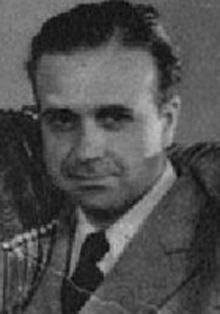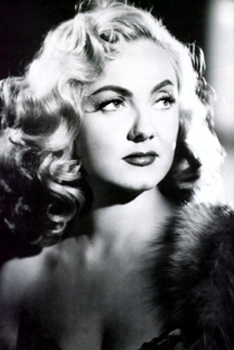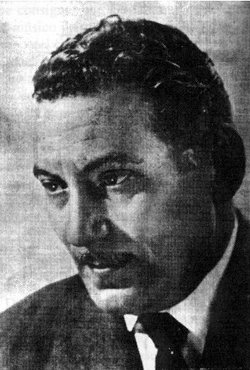
Libertad Lamarque Bouza was an Argentine-Mexican actress and singer, one of the icons of the Golden Age of Argentine and Mexican cinema. She achieved fame throughout Latin America, and became known as "La Novia de América". By the time she died in 2000, she had appeared in 65 films and six telenovelas, had recorded over 800 songs and had made innumerable theatrical appearances.

Angélica María Hartman Ortiz, known professionally as La novia de Mexico, is a Mexican actress and singer. Her songs El hombre de mi vida peaked at No. 6, Reina Y Cenicienta peaked at No. 9, Prohibido (Prohibited) peaked at No. 13, and El Taconazo peaked at No. 34 on the hot Latin songs chart.
The Martín Fierro Awards is the name of the most prominent awards for Argentine radio and television, granted by APTRA, the Association of Argentine Television and Radio Journalists.

Luis Alcoriza de la Vega was a respected Mexican screenwriter, film director, and actor.

María del Socorro Tellado López, known as Corín Tellado, was a prolific Spanish writer of romantic novels and photonovels that were best-sellers in several Spanish-language countries. She published more than 4,000 titles and sold more than 400 million books which have been translated into several languages. She was listed in the 1994 Guinness World Records as having sold the most books written in Spanish, and earlier in 1962 UNESCO declared her the most read Spanish writer after Miguel de Cervantes.

Mecha Ortiz was a classic Argentine actress who appeared in films between 1937 and 1981, during the Golden Age of Argentine Cinema. At the 1944 Argentine Film Critics Association Awards, Ortiz won the Silver Condor Award for Best Actress for her performance in Safo, historia de una pasión (1943), and won it again in 1946 for her performance in El canto del cisne (1945). She was known as the Argentine Greta Garbo and for playing mysterious characters, who suffered by past misfortunes in love, mental disorders, or forbidden love. Safo, historia de una pasión was the first erotic Argentine film, though there was no nudity. She also played in the first film in which a woman struck a man and the first film with a lesbian romance. In 1981, she was awarded the Grand Prize for actresses from the National Endowment for the Arts.

Francisco Múgica was an Argentine film director, film editor and cinematographer. He was born and died in Buenos Aires.

Olga Zubarry was a classic Argentine actress who appeared in film between 1943 and 1997. She made over 60 appearances in film, spanning 6 decades of Argentine cinema, but is best known for her work during the Golden Age of Argentine Cinema. Throughout the course of her career, she received four Silver Condor Awards, two Martín Fierro Awards, a Konex Foundation Award and several others for her films and television performances. She is credited with starring in the first film in Argentina which featured nudity, though only her back was shown and she stated repeatedly that she wore a flesh-colored mesh and was not truly nude.

Carlos Francisco Borcosque Sánchez was a Chilean film director and screenwriter involved in the production of the Cinema of Argentina.

Laura Ana "Tita" Merello was an Argentine film actress, tango dancer and singer of the Golden Age of Argentine Cinema (1940–1960). In her six decades in Argentine entertainment, at the time of her death, she had filmed over thirty movies, premiered twenty plays, had nine television appearances, completed three radio series and had had countless appearances in print media. She was one of the singers who emerged in the 1920s along with Azucena Maizani, Libertad Lamarque, Ada Falcón, and Rosita Quiroga, who created the female voices of tango. She was primarily remembered for the songs "Se dice de mí" and "La milonga y yo".

Enrique Carreras was a Peruvian-born Argentine film director, screenwriter and film producer, and was one of the most prolific film directors in the history of the Cinema of Argentina.

Carlos Cores was an Argentine film actor, and film director.
Carlos A. Petit was an Argentine screenwriter. He was one of the most prominent screenwriters in the Cinema of Argentina, writing for over 30 films between 1941 and 1984.

Américo Hoss was a prolific Hungarian-Argentine cinematographer.

Alberto Closas Lluró was a prolific Spanish film actor who appeared in the Cinema of Argentina in the 1940s and 1950s and in Spanish cinema after 1955.

Zulema Esther González Borbón, better known as Zully Moreno, was an Argentine film actress of the Golden Age of Argentine Cinema (1940–1960). She appeared in more than 70 movies, earning best actress awards from the Argentine Academy of Motion Picture Arts and Sciences and the Spanish Cinema Writers Circle.

Ángel Magaña was an Argentine film actor who appeared in some of Argentina's notable films of the 1930s, 1940s and 1950s.

Emilia Guiú Estivella was a Spanish-Mexican actress who appeared mainly in Mexican films, particularly in the 1940s and 1950s in the Golden Age of Mexican cinema. She made over 60 film appearances between 1943 and 2000 and typically played villain roles and "femme fatale". She also made a number of theatrical appearances.

George Andreani, pseudonym Josef Dvořáček (born as Josef Kumok; 28 February 1901 in Warsaw, Poland – 2 April 1979 in Buenos Aires, Argentina) was a Polish composer, film score composer, pianist, conductor, and actor. He was noted for his scores of some 75 Argentine films during the Golden Age of Argentine cinema from 1937 to 1959. Aside from his prolific work as a score composer, he was also conductor of the Orquesta Sinfónica Schenley in the 1940s.

Alberto Amado Ribero, known professionally as Tito Ribero, was an Argentine film score composer, composer, singer, and musician. In addition to having his own orchestra, he provided the film scores to over 200 movies, at his most prolific in the 1950s and 1960s. For Del otro lado del puente he won the Silver Condor Award for Best Original Score from the Argentine Academy of Cinematography Arts and Sciences in 1953.


















